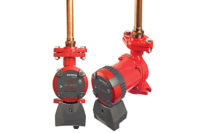Based on temperature demand, a circulator pump is an essential component that moves water in a boiler system loop to provide heat to a building through radiating devices like radiators or heating baseboards. Circulator pumps are also used in on-demand hot water applications where the hot water in the pipes are circulated through the hot water heater.
In commercial buildings, circulator pumps are often overlooked for energy efficiency upgrades due to their smaller size. But as the workhorse of hydronic heating systems, circulator pumps can be the key to unlocking significant energy savings.
Building owners are increasingly focused on reducing lifecycle costs in equipment and overall building costs, and the COVID-19 pandemic has only served to accelerate interest in smart HVAC technology like circulator pumps.
As the urgency to make commercial buildings healthier and more energy efficiency intensifies, new construction and retrofits of existing buildings is paving the way for growth of the hot water circulator market.
Designers and installers typically look for reliable pumps that are easy to install and maintain for their application. Additionally, they look for a single circulator size that can adapt to a broader range of capacities and control logics to reduce the number of stocking units in their inventories.
Building owners also value pump reliability, convenient start-up operation and easy unit maintenance, but more and more, they are shifting their focus to convenient monitoring controls and lower operating costs.
Improved motor design
As a result of the growing demand for higher efficiency, the hydronics industry has shifted largely to circulator pumps that feature Electronically Commutated Motor (ECM) or Variable Frequency Drive (VFD) motor technology. The advantage is these types of systems allow the control logic to adjust the motor RPM speed to match the exact flow and pressure required for heating and cooling demands based on temperature or other signals. This works to efficiently reduce energy waste and ultimately save on the electric bill. In many states, there are rebate incentives for these types of greener installations.
With more efficient variable speed motor design, it is not uncommon for building owners to experience 50% to 80% electrical energy savings. Specifically, the intelligent speed control on ECM circulators is drastically reducing energy use without sacrificing performance.
Advanced microprocessors are further accelerating motor technologies, from simple applications to heavy industry, by adding new capabilities. These smart devices are capable of collecting performance data and display it to technicians. They also allow more interactive controls and wireless options. This again helps to create a more efficient system. Some of these technologically advanced pumps can use the real-time results to adjust a building’s system.
The permanent magnet motor along with the feedback loop control using a microprocessor-based controller helps reduce the overall power consumption of this circulator pump. The microprocessor constantly learns the system requirements and usage pattern and adjusts the speed of the pump by changing the pump performance curve.
Intelligent connection
Among the latest trends in circulator pumps is more sophisticated automation control options. The buzz word currently is “smart pump” in the IoT universe where they are capable of self-diagnostic controls. Outfitting circulator pumps with better controls can deliver higher efficiencies that can save costs and be more environmentally friendly.
By adding a brain to the package, circulator pumps can now be further manipulated to almost the exact requirements of the end user. The latest circulator pumps can connect to a mobile device like a cell phone or tablet via Bluetooth wireless technology. This allows you to remotely choose one of the many control logic options and monitor the system operation like flow, pressure, temperature and motor speed. This will also display any errors and system faults that may occur for troubleshooting. Having this type of connectivity and convenience will eventually become the new standard for the next generation of users.
In addition to maximizing energy efficiency without compromising system performance, circulator pumps featuring built-in intelligent controls and smart communication capabilities can help end users reduce the number and types of pumps required for typical building HVAC and plumbing installations. This benefits a range of facilities, including universities, office complexes, airport terminals, manufacturing facilities and similar buildings.
The future of circulator pump innovation
Current and widely available circulators have the ability to adapt to ever-changing requirements found in zoned systems. Smart pumps have the ability to sense changing flow requirements and reduce or increase flow rates to match and maximize the flow performance.
As pump manufacturers continue to seek out engineered equipment that will meet evolving energy standard requirements, the future of circulator pumps will rely on the continued development of these type of technologies with more advanced control logics and greater motor efficiencies.




